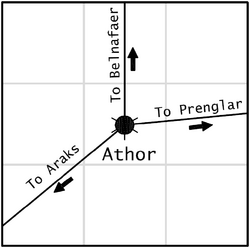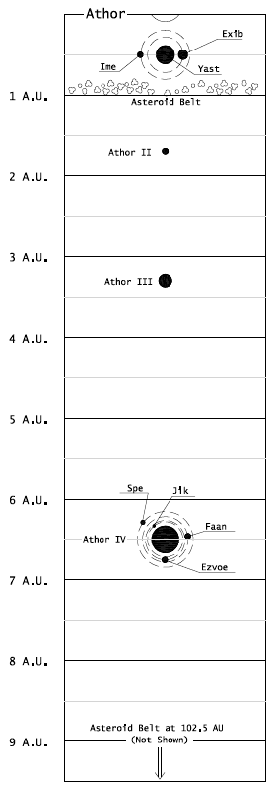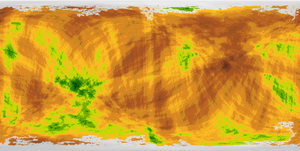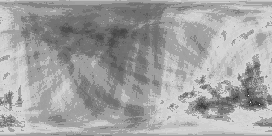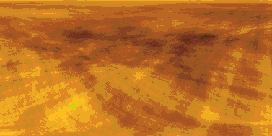Athor System
From Star Frontiers Network
by Goblinardo
| Star Data | |
| Star Type | K2 Orange Main Sequence |
| Radius | 6.09 x 105</sup) km (0.87 Sol) |
| Mass | 1.46 x 1030 kg (0.73 Sol) |
| Temperature | 4,300 degrees Kelvin |
| Luminosity | 1.03 x 1026 W (0.27 Sol) |
Contents |
Athor System History
Discovered in 250 PF by the scouts to the Yazirian Exploration Fleet, the Athor system was notable for a few things:
- There are two separate asteroid belts around the system. The closest one to the star is about 0.9 AU and farthest one is about 102 AU out. This means that the system is protected by a “speed bump” that prevents a ship from safely jumping into the Athor system any further than the farthest asteroid belt. However, in a quick nod to the phrase that, “nothing is for free,” the farflung asteroid belt also prevents ships from quickly leaving the system.
- There is a (barely) habitable planet lying about 0.5 AU from Athor. This planet, named Yast, is a large desert planet which, in turn, is orbited by the moons Exib and Ime1.
1 The moons of Yast were supposedly named after the children of the Captain of the Yazirian scout ship that discovered the Athor system. In light of the characteristics of the moons, one wonders how the children liked their namesakes.
The system was left as is and acted as a “scenic stop” of sorts for ships traveling in and around the Yazirian Arm of Frontier space for around two decades until a dedicated push from the Hierarchy on Hentz put (read: exiled) a concentrated group of colonists in place in the system in 235 PF.
These colonists had the distinction of being from a block of eight clans who were notable for their increasingly strident protests against the injustices (real and perceived) from the theocratic – one clan based government of Hentz. Also, the discovery of other sentient life forms led to a greater questioning of accepted religious doctrine, and these eight clans were chief amongst those loudly asking these questions. The Hierarchy decided to displace these clans rather than destroy them completely, but few would have considered relocation to Yast as an “escape” of any sort.
The Hierarchy terraformed Exib in during the 222- 203 PF period to relieve the pressure on Hentz’s resources of having to feed those on Yast (and other places) and also to have an additional source of food for themselves if and when they needed it. This relatively helpful gesture by the Hierarchy was offset in the colonists’ eyes by the continued use of Yast as a dumping ground for the unwanted of Hentz. Yast, it seemed, had become a penal colony in all but name.
The years of 200-170 PF are noted for the increasing independence of Yast from the (slight) assistance of Hentz. The combination of the natural minerals in the soil on Exib, the results from the terraforming, the proximity of Athor, and the unexpected response from native Yazirian plants to all of the above provided a tremendous amount of revenue and clout for the colonists on Yast. In addition to the Yazirian market, the bounty from Exib found receptive markets on Prenglar and further, which in turn, provided invaluable contacts outside of the Hentz regulated channels that were the norm. These contacts would pay dividends as seen in 168 PF.
Tensions between the colonists of Yast and the Hierarchy came to a head in 168 PF after the Church Elders had decided the previous year to take a stronger role in colony oversight/control. This meant an increased presence of Church Controllers and Church Security Forces in and around Yast. For those in the Athor system, who had wrested something away from a system that had so little to offer initially with very little support from their home, this act by the Hierarchy was the last straw. In mid 168 PF, the Thirty Cycles War began between the colonists of the Athor system, and the Hierarchy on Hentz. The independence of the Athor system was the prize.
The colonists fought a purely defensive war, and the nature of the Athor system itself provided the edge needed for this strategy to work. With all of the approaches mined, a highly mobile fleet hiding in the two asteroid fields, and a ground force forged from the unforgiving desert itself, the colonists were also bolstered by support from various groups elsewhere in the Frontier.
The (now) rebel colonists also utilized mercenaries to harass some of Hentz’s peripheral operations, but this was done more to draw off forces from the colonists’ necks than to cause lasting damage to the Hierarchy.
The Hierarchy could not crack the lines to get into Yast, and once engaged the colonists fought with a fury that was shocking even to Yazirians. By late 168 PF, and after several failed invasion attempts, the Hierarchy capitulated to the colonists’ terms and formally recognized those of the Athor system to be “well and fully independent from Hentz from this time forth.”
A quiet, if somewhat uneasy, peace has existed between Araks and Athor since.
The People
(An excerpt from The Greater Frontier Gazetteer; 5th Ed. By Lazlo Fee, Professor Emeritus, Zebulon University, Zebulon)
“Fierce, but free,” (description of a Yazirian from Yast by Dralasite trader Kayeku Duuya).
The Yazirians from the Athor system are, generally, a serious bunch. They work diligently, almost feverishly, at a problem until it is solved. Also, when a problem occurs, it is accepted that anyone and everyone who can will help out until they are not needed any more. Granted, these are broad statements to be sure, but they are fairly accurate of the Athoran mindset as a whole.
2 When mentioning “those native of Yast,” or, “native Athorians,” keep in mind that this phrase applies to those that are living in the Athor system; everything and everyone are inextricably tied to a single future. To make reference to the planets, moon(s), and anywhere else in the system over and over would be somewhat dismissive of the linked nature of their culture.
The ability and social proclivity to work together on a problem should not be mistaken for weakness in those native to Yast2; there are no weapons laws per se (although toting a surface-to-air missile through town is looked at as bad form, for example) and duels between individuals are commonplace. “Native” Athorians speak Gnarsh (an old variant of the Argonian language spoken on Araks) amongst themselves, but Pan-Gal is, of course, the accepted alternative.
The rule on Hentz of the clothes denoting your job and position was done away with on Yast. Instead, personal choice is the rule of the day. However, it was noted that some kind of uniform is necessary for some jobs. But, it will be a fact that no two uniforms will look alike either. Capes, always popular amongst Yazirians, are even more so to those from Yast.
An interesting side effect of the “anti-Hentz” way of life that developed on Yast is that the Athorians are quite private when it comes to who they are and what they do. While they certainly are not ashamed of whatever job it is that they have, they do not wish to advertise it either. This has lead to a unique job niche available for robots and foreigners who act as go-betweens or proxies for those Yazirians who feel that their jobs might be somewhat distasteful or otherwise looked down upon by others. It seems that despite the hard won independence, the years of making their own way in the Frontier, and the resolute desire to not be anything like the Yazirians of Hentz, the people of Yast, the former colonists of Hentz, cannot yet get over a part of their history. Time will tell if and when this particular idiosyncrasy of Athorians will ever go away.
Traveler’s Warning: Do not ever utter the phrase, “You wear your position well,” or something similar to a Yazirian from the Athor system. This is taken as an insult (it refers to their much hated history on Hentz), and will most certainly result in an honor duel. A duel with not only the person you are speaking to, but to any other Yazirian who might be in earshot. And as a bit of spice to that tasty cake of wisdom, if you happen to survive the (doubtless) multiple honor duels you will undertake, you will most certainly have the (iffy) authorities to deal with as well afterwards. Remember: the prisons of Athor are dark, deep, and full of “accidents.” You’ve been warned.
Places of Interest
- Port Asteall – The first colony on Athor. It lies within a bowl of rock which has been carved out and worked into numerous passageways, homes, businesses and the like. Rock excavated from the operations went to make the expansive landing fields inside the bowl; fields which can easily take a ship up to frigate size and still have some room to spare. The capitol of Athor can be found here, as well as representative offices to all of the founding clans of Athor, most Frontier Mega Corporations, and Spacefleet and Landfleet recruiting offices. There are numerous other businesses and entertainment venues available to the traveler as well.
- Solace – One of the more infamous Supermax prisons of the UPF, it was made from hollowing out a gigantic mesa in the southern hemisphere of Athor (well away from anywhere). Tremendous defenses protect Solace from the outside, and crack companies of Star Law Corrections Officials man the stations inside. Also, it is not uncommon for Landfleet to have units passing through for desert training staying in and around Solace. If, somehow, a creature could make it through all of the security defenses in place, they would still have the desert to deal with once they got outside. Truly a forbidding place.
- ??? – In the period between 25-22 PF, Hatzck Naar was the one of the first big name pirates to raid the space lanes throughout the Frontier. He also had the distinction of causing the first Common Muster to be called against him which resulted in the destruction/disbanding of Naar’s fleet and the death of Naar himself. His base of operations was in the Athor system, but few other details are available. However, local legends tell of a motley crew who staked their claim in the Azva Wall (which lies around 300 km south of Port Asteall) that just disappeared one day. Or, stories abound of the hell-raising crew of scoundrels that were the toast of numerous dives on Exib, and at Laaka’s Station who spent well but who were just gone one day and never seen again.
- Laaka’s Station – Based on one of the largest asteroids in the belt which lies closest to Yast, Laaka’s Station has been a staple for asteroid miners, spacer crews, and UPF Spacefleet personnel for years. The Bazaar on Yellow Deck at the Station is a wondrous market where nearly anything can be found. Mom’s Place on Blue Deck is infamous for the sheer variety of drinks (and fights) to be had at any time of day. Be advised: travelers should expect the usual rules to be in place in regards to what kind of weaponry is allowed at the Station. If it can make a big hole in a wall, then leave it on the ship. Failure to follow this general rule could lead to trouble for the offender.
- New Khir – Main space port on Exib; it lies at the base of the beautiful Green Mountain range near the southern terminus of the range and near the Fairfield Plains. As might be expected, New Khir is one busy place for most of the Standard year, but all stops are pulled out when it’s the Annual Harvest Festival. During that Standard week, all manner of revelry is had to celebrate another year of crop production and to also celebrate the independence from Hentz.
Other Items of Note
The government of Athor is built upon a democratic model in which all eligible citizens are expected to serve a 2 year term at some point or another in their life. These representatives are chosen through a variety of ways: random selection, volunteering when able to, and if their skills are needed. Those that do well in this capacity can expect to be well compensated for their work. Those that abuse their position can expect to pay for their mistakes one way or another at some point down the line. While chancy sounding, this type of government works well for a people who value freedom as much as Athorians do.
Freighter captains traveling into the Athor system who do not belong to the system’s only sanctioned transportation line and are picking up/dropping off any product at Yast or Exib can expect to have their vessels quarantined and thoroughly inspected because of fear of contamination of the crops on Exib by diseases or insects. Officials from the Health and Safety Services will comb over every single centimeter of every ship coming in with various devices in order to find any trace of contaminant and a total clean up of a “dirty” ship is not uncommon. The inspection/clean-up complex for this parked in orbit just on the far side of the nearest asteroid belt from Yast. A secondary complex, which is in orbit at the same point on the opposite side of the system, fulfills the same duty and allows for a much faster pass-through period for everyone.
System Data
| Athor I (Yast) | |
| Type | Terrestrial, Arid, Cold |
| Orbital Radius | 8.1E+07 km (0.541 AU) |
| Year | 167.93 Standard days |
| Gravity | 0.99 |
| Habitable World Data: | |
| Day | 15 hours |
| Hyrdosphere | 0% (12.4% Ice) |
| Atmosphere | Thin, breathable |
| Climate | -67.6oC to 54.3oC, Avg. -3.1oC |
| Trade | Many and various enterprises exist |
| Native Life | No sentient life found. Native life generally small and simple. |
| Government | Democracy |
| Population | Light, 90% Yazirian |
| Athor Ia (Exib) | |
| Type | Terraformed moon, Terrestrial |
| Orbital Radius | 8.1E+07 km (0.541 AU) |
| Year | 167.93 Standard days |
| Gravity | 0.74 |
| Habitable World Data: | |
| Day | 37.80hours |
| Hyrdosphere | 81.6% (4.2% Ice) |
| Atmosphere | Breathable |
| Climate | -30.3oC-44oC, avg. 8.6oC |
| Trade | Agriculture |
| Native Life | None, all imported by colonists |
| Government | Democracy |
| Population | Moderate, 90% Yazirian |
| Notes: | |
| Terraformed moon which has become the economic center of the Athor system. | |
| Athor Ib (Ime) | |
| Type | Moon, airless rock |
| Orbital Radius | 8.08E+07 km (0.540 AU) |
| Year | 167.9 Standard days |
| Gravity | 0.28 |
| Athor II | |
| Type | Ice Planet |
| Orbital Radius | 2.54E+08 km (1.70 AU) |
| Year | 538.5 Standard Days |
| Gravity | 1.21 |
| Notes: | |
| Athor II has been named several times by different writers, poets, and explorers. No name ever stuck for certain, but many children of Athor refer to this cold, lifeless world as the place that bad little Yazirians go when they die. This is more urban legend than religion, and adults may occasionally be heard to say someone has the “Heart of Athor II” – meaning cold and evil. | |
| Athor III | |
| Type | Sub-Jovian |
| Orbital Radius | 4.94E+08 km (3.3 AU) |
| Year | 3406.03 Standard Days |
| Gravity | -- |
| Notes: | |
| This sub-jovian world didn’t quite blossom into a star, and didn’t quite settle into a solid mass. The surface is constantly in motion, colored in blue hues (though these colors are muted from view by the ammonia in its sparse atmosphere). | |
| Athor IV (Srah) | |
| Type | Jovian |
| Orbital Radius | 9.72E+08 km (6.5 AU) |
| Year | 43562.49 Standard Days |
| Gravity | -- |
| Notes: | |
| Athor IV was named after the first female elected official, Premier Srah of Athor. She was noted, as is this planet, for fits of catastrophic fury that can destroy those who stand too close to it. It is known that three of Srah’s moons have been destroyed, pulled into and absorbed by this unstable planet over the eons. But four still remain. | |
| Athor IVa (Jik) | |
| Type | Moon, airless rock |
| Orbital Radius | 9.72E+08 km (6.5 AU) |
| Year | 43564.40 Standard days |
| Gravity | 0.34 |
| Athor IVb (Ezvoe) | |
| Type | Moon, airless rock |
| Orbital Radius | 9.72E+08 km (6.5 AU) |
| Year | 43564.40 Standard days |
| Gravity | 0.45 |
| Athor IVc (Faan) | |
| Type | Moon, airless rock |
| Orbital Radius | 9.72E+08 km (6.5 AU) |
| Year | 43564.40 Standard days |
| Gravity | 0.34 |
| Athor IVd (Spe) | |
| Type | Moon, airless rock |
| Orbital Radius | 9.72E+08 km (6.5 AU) |
| Year | 43564.40 Standard days |
| Gravity | 0.33 |
''Note: The two asteroid belts at 0.9 AU and 102.5 AU are not given detail here. These belts are composed of typical asteroids and are generally moderate to light in overall composition (meaning, their density in relationship to each other). Other than the usual sort of mineral mining that occurs in these belts, there is nothing more to add. It is possible for scavengers to come across outdated wreckage of ships left over from the Yazirian civil conflict “The Thirty Cycles War.”
